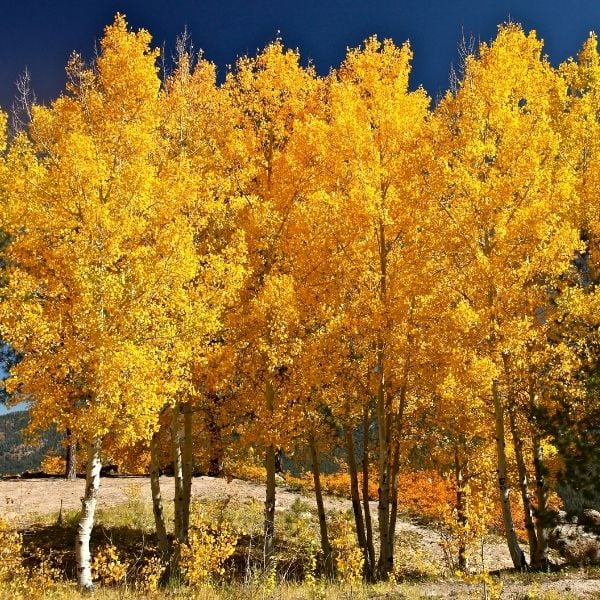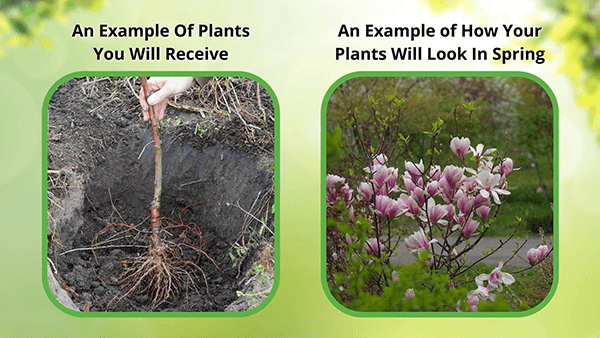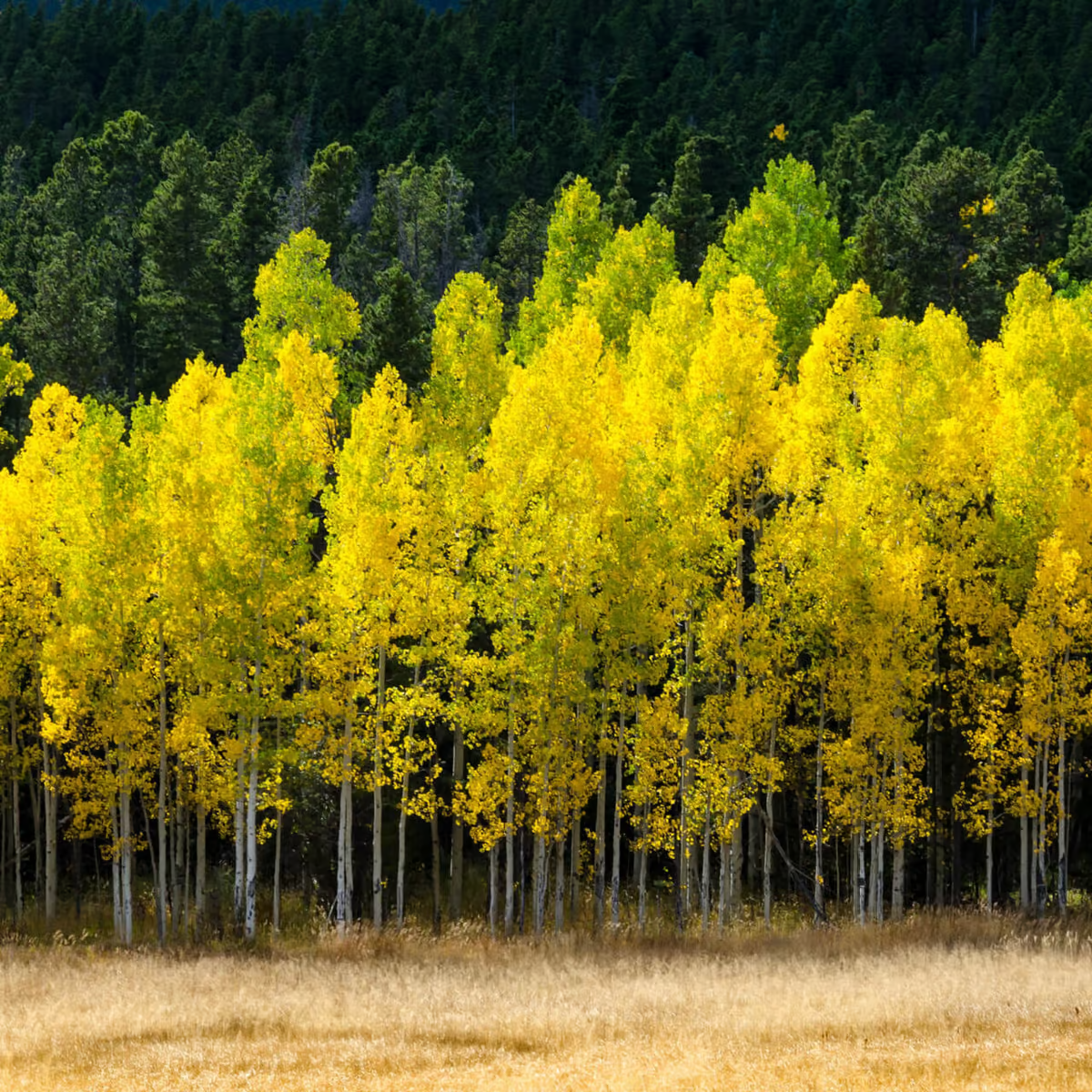





Quaking Aspen
Stunning fall foliage display
Fast-growing shade tree
Erosion control benefits
Thrives in
ZONE 2ZONE 3ZONE 4ZONE 5ZONE 6This plant ships:
November 20251 Year Guarantee on all plants
Quaking Aspen - Populus tremuloides
Quaking Aspen (Populus tremuloides) is a native deciduous tree recognized for its golden autumnal color and distinctive white bark.
Plant Details - Quaking Aspen
Family: Salicaceae
Light Requirement: Full Sun
Water Needs: Moist
Height: 40 – 50 ft.
Spread: 20 – 30 ft.
Growth Rate: Fast
Bloom Time: Spring
Flower Color: White
Wildlife Value: Attracts birds
Landscape Uses and Maintenance - Quaking Aspen
Quaking Aspen has wide, heart shaped leaves and beautiful white bark. Its leaves will create a beautiful fall display, changing to gold.
This tree is an excellent choice when planted as an accent tree in your yard, or as a focal point in open woodlands. Great for creating a living hedge or privacy screens.
This tree can be planted in either full sun to partial shade. However, this tree performs best with the full six hours of sunlight.
Plant this tree in well draining soil. It can tolerate different soil types, including sand, loam, clay, and wet soil, making this tree a very versatile option.
Water your new tree thoroughly when first planted until it is well established. Make sure to water it during drought as this tree has a low level of tolerance for drought, especially during the hot summer months.
This tree does not have ornamental flowers. Rather, the tree has small catkins that are not showy. The catkins are interesting to look at, with long wisps of white hairs and red stamens.
This tree does have a thinner, ornamental bark, so watch closely for signs of insect damage and treat as soon as possible. Prune any damaged, rubbing, or diseased branches to limit fungal or bacterial spread.
This tree is very attractive to plenty of wildlife, including birds and deer. Protect your new tree while it is young with caging or fencing in order to avoid damage from animal browsing.
It is a host plant for many local butterflies, including the Eastern Tiger Swallowtail.
Noteworthy Characteristics
Quaking Aspen has many suckers that will develop, so take care to remove them with pruners if you do not have the space for additional aspen trees.
This Is How Your Plants Will Look upon Delivery

Bloom Season
Spring
Bloom/Foliage Color
Yellow
Height at Maturity
Over 25 Feet
Care
Quaking Aspen trees thrive in well-drained soil and should be drenched regularly, particularly during dry periods. Trim to retain shape and clear dead or damaged limbs. They’re prone to pests and diseases, so monitor them closely and treat any issues promptly.
Plant Reproduction
The spreads via root suckers forming extensive colonies.
Plant bare root trees during the dormant season in early spring or late fall (November through April). Dig the hole twice as wide as the roots so the soil is well-drained. Position the tree so the root flare is at or just above ground level. Fill the hole back with the soil you dug from and water. Maintain soil moisture, especially in the tree's early years, by providing deep, regular watering. Apply a 2-4 inch mulch away from the trunk at the base to retain moisture and suppress weeds. Prune trees during the first few seasons to establish strength and resilience, remove damaged branches, and continue maintenance pruning as the tree matures. Regularly inspect for pests and diseases and apply integrated pest management practices. Protect young trees from mechanical damage and extreme temperatures with tree guards, and stake them if necessary for support, removing the stakes after one or two years.
Shipping date depends on the date displayed and chosen when you order from the product's page.
We only accept returns on plants verified dead. If you think your plants have died, we offer a 1 year warranty, please use this File a Claim Link to verify dead plants and start with return warranty process.








Stunning White Bark:
Adds a unique and elegant touch to any landscape, making it a garden standout.
Mesmerizing Leaves:
Flutter gracefully in the breeze, creating a shimmering effect that brings movement to your garden.
Fast Growth:
Provides rapid shade and privacy, perfect for new gardens needing quick coverage.
Wildlife Attraction:
Attracts birds and deer, enhancing your garden's natural beauty and biodiversity.
Caring Tips
How do I care for my Quaking Aspen?
Each box contains detailed care instructions and information about your product. But here's the basics.
Care Tips
Quaking Aspen trees thrive in well-drained soil and should be drenched regularly, particularly during dry periods. Trim to retain shape and clear dead or damaged limbs. They’re prone to pests and diseases, so monitor them closely and treat any issues promptly.
Light Requirements
Quaking Aspen thrives in full sun to partial shade. It prefers at least 6 hours of direct sunlight daily but can tolerate some light shade. Optimal growth occurs in sunny locations with well-drained soil.
Hardy Planting Zones
2 • 3 • 4 • 5 • 6
Header
Use this content to share information about your store and products.
Frequently Asked Questions
How often should I water my plants?
How do I know if my plant is getting too much or too little sunlight?
What should I do to prepare my plants for winter?
What are the signs that my plant needs fertilizing?
How can I prevent pests from damaging my plants?
How do I choose the right plant for my climate zone?






